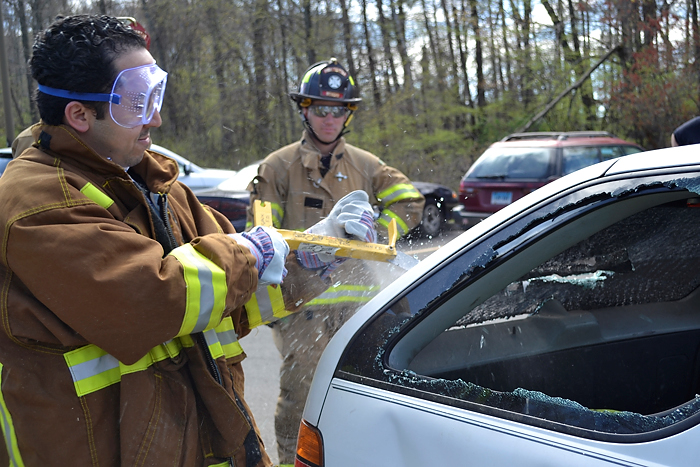A unique training session led by UConn fire department personnel helped medical residents gain a better perspective on what accident victims experience before they are treated in the emergency department.
About a dozen second-year emergency medicine residents gathered outside the Health Center’s fire station on Circle Road Tuesday where a badly damaged car sat waiting for them.
While air bags and crumple zones have made the inside of newer model cars much safer for drivers and passengers, the outside can still sustain heavy damage, which makes extricating the victims a real challenge.
Fire Lieutenant Anthony Ruggiero says in some ways their job is even more difficult with the high-strength steel that cars are now made of, making it difficult for their tools to break through.
During the training session, residents donned protective eye goggles and were given a first-hand chance of using the rescue tools, including a saw that cuts through glass and a spreader and cutter (often referred to as the “jaws of life”).
“The residents get a feel for what it truly means to cut a person out of a car,” says Ruggiero. “They get to know the difference between a 30-minute extraction and a 15-minute one, or a heavy entrapment versus a light entrapment.”
“Now when the paramedics tell us it was a 20-minute extraction, it’s not just an arbitrary number,” says resident Gilberto Arbelaez. “We know there was probably heavy damage to the car and we can better anticipate what kind of injuries the victim may have when they arrive in the ED.”
Another aspect of the training includes residents acting as victims in order to gain a patient’s perspective. Katherine Fellman, wearing protective gear and a blanket to protect her from breaking glass, sat behind the steering wheel while her fellow residents sawed, smashed and pried open the car’s crumpled door.
“It was disorienting. I couldn’t see anything and it was hot and noisy,” says Fellman. “It would probably be a horrendous experience for a patient who was seriously injured and unsure of what was happening.”
Ruggiero says that’s why a paramedic is in the vehicle during the extrication to help calm the victim and start the treatment process.
The training session provides another potential benefit – familiarity. “It allows us some face time,” explains Ruggiero. “If they hear us on the radio when we patch into the hospital or when we come in to give them a report on a patient, they will already know us and have more trust in our judgment.”
“They see what we do, now we get to see what they do,” says Fellman. “It makes me more appreciative of the challenges they face on a daily basis.”
Follow the UConn Health Center on Facebook, Twitter and YouTube.



